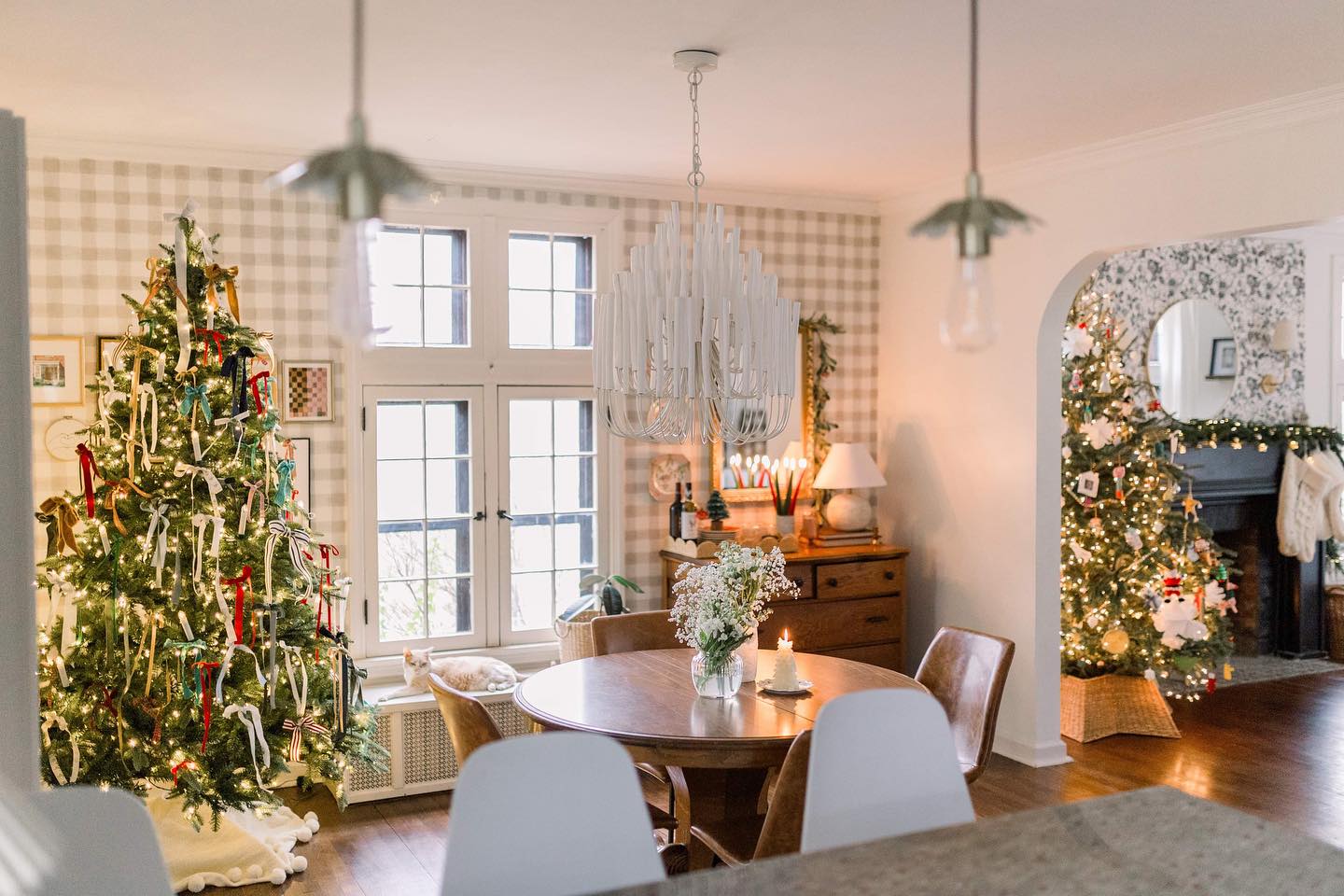Holidays the Old School Way
Picking up a prepared Thanksgiving dinner at the local supermarket. Hiring an interior designer to decorate the house — including the tree. Calling the caterer to supply all the food and beverage for your annual holiday bash. Ordering gifts onlin
by Lynne Thompson | Sep. 28, 2006 | 4:00 AM
Preparing the turkey
You can astound your family by preparing the main course like an expert this year. Don’t be intimidated by a lack of experience. Jean Geiser, a housewares product specialist at Lehman’s in Kidron, Ohio — located in the heart of Amish Country — says holiday hosts approach her with how-to questions every year.
“I’ve got married children who bring home their turkeys so Mom can cook them,” she says good-naturedly. She offers the following instruction in preparing a frozen bird, including a modified stuffing recipe (“It’s the only one I use”) from her 1950 copy of “The Mennonite Community Cookbook” by Mary Emma Showalter.
Read the package instructions for defrosting the turkey and note the required cooking time, which is determined by weight. Depending on the bird’s size, you may have to get it in the oven well before sunrise if you want to eat at noon.
Remove the packaging and pouch of giblets (the gizzard, heart and neck) stuck inside the turkey or under the flap of skin at the neck. Rinse the turkey, inside and out, in cold water, place it in a foil-lined roaster and refrigerate.
Some people throw the giblets away or cook only the neck to yield the broth called for in the stuffing recipe. Others cook all three parts to produce the broth and chop up the gizzard, heart and meat off the neck for use in the dressing. To prepare the giblets, bring them to a boil in a saucepan filled with 2 1/2 cups water, then cover and simmer for 30 to 45 minutes, or until the meat on the neck can be easily removed with a fork. Strain and reserve 2 cups of broth for use in the following stuffing recipe:
2 quarts toasted soft bread cubes (at least 1 1/2 loaves of white bread required)
6 eggs
4 cups milk or 2 cups milk
and 2 cups chicken or turkey broth
4 tablespoons butter
2 tablespoons chopped parsley
2 teaspoons minced onion
2 teaspoons salt
2 teaspoons sage or poultry seasoning
Toast bread in toaster and cut into 1/2-inch cubes to produce 2 quarts. Beat eggs and add milk or the milk and broth mixture. Pour liquid over bread cubes. Add melted butter, parsley, onion and seasonings and mix well. Stuff into turkey.
Close the cavity opening using a large needle and cooking twine or by pulling what remains of the tail over the opening and tying the ends of the legs together. “You have to keep the dressing contained inside the turkey,” Geiser warns. Brush the turkey with melted butter and then rub it with a mixture of 1 teaspoon ginger and 1 teaspoon salt. “It not only helps brown the turkey,” Geiser says, “but it gives it a little bit of flavor.”
Cover and place the bird in the oven, baking according to package directions (if the roaster lid won’t fit, a well-constructed “tent” of foil will suffice). Take off the roaster lid or foil a half hour before removing the turkey from the oven to facilitate browning. Let the turkey sit for 10 to 15 minutes before spooning out the stuffing and carving.
Pumpkin pie from scratch
We’re talking about starting with a real, honest-to-goodness pumpkin here, not the canned stuff. Heather Faur, of Hale Farm and Village, a 19th-century outdoor living-history museum in Bath, provides an updated version of an 1839 recipe from “The Kentucky Housewife” by Lettice Bryan that she uses on the job as a costumed master interpreter. The slightly darker color of the pie and difference in flavor are a result of using brandy rather than lemon and vanilla to give the filling its fruitiness.
“It’s not as sweet as a modern pumpkin pie,” she says. “People didn’t always use a lot of sugar in their pies. They were often meant to be eaten with a sauce [in this case, sweetened cream] and a side garnish.”
The key ingredient, of course, is still a pumpkin — not the enormous thing you carve at Halloween, but a smaller pie pumpkin, which is sold in the produce department of some grocery stores. Karen Ramseyer of Ramseyer Farms in Wooster suggests varieties such as Sugar Pie and Octoberfest. She recommends selecting a heavy gourd that doesn’t produce a “hollow” sound when gently thumped with the hand.
“Small- to medium-sized [6- to 8-pound] pumpkins are best for baking and cooking because they have a finer-textured flesh than very large ones,” Ramseyer explains.
Heather Faur suggests preparing the pumpkin — the recipe calls for a medium-sized one that will yield approximately two cups when stewed — much like you would for carving: Slice off the stemmed top and scrape the inside clean, making sure to remove all seeds and pulp (“the stringy matter”) from the inch-and-a-half of firm, pale-yellow flesh. The remaining shell (flesh and dark-orange rind) is then sliced like a watermelon, cut into 1-inch cubes, stewed in a large saucepan with 1/4 cup water over low heat until very soft and mashed to a pulp. The rind can be removed before or after cooking but before mashing. Faur says stewed pumpkin can be used in the same quantities as its canned counterpart in other recipes.
The rest of Faur’s recipe follows. Because it was developed for use with the deeper pie plates of the 19th century, it may yield enough filling for two modern-sized pies.
Prepare a crust with 1 cup flour, 1/4 cup butter and 3 tablespoons cold water. Roll crust out and line a 9-inch pie plate.
Filling:
2 cups pumpkin, stewed and mashed
2 cups milk
1/2 cup brown sugar
2 tablespoons butter
3 eggs
1/4 cup brandy
ground cinnamon, cloves and nutmeg to equal 1 tablespoon
Combine the pumpkin, milk and brown sugar in a large saucepan and place on medium heat. When it begins to boil, add the butter and remove from heat. Allow to cool slightly. Add the eggs, brandy and spice, stirring constantly to keep eggs from cooking in the heated pumpkin.
Pour the pumpkin mixture into the crust, flute edges and bake at 350 degrees Fahrenheit until pumpkin is set (a toothpick can be removed cleanly). Allow to cool before cutting.
How To: Make a traditional cornucopia An age-old harvest symbol, this horn of plenty has adorned Thanksgiving tables as long as turkeys and potatoes. It evokes memories of Thanksgivings past, a Norman Rockwell holiday spread on starched white linens. You’re on your own for the sure-to-be-short-lived white tablecloth, but you can revive a great Thanksgiving tradition by making your own cornucopia. It’s even simple enough to keep the kids busy while you baste your bird. |
Making eggnog
Ritz-Carlton Cleveland executive chef Chad Ellis’ favorite recipe for the traditional holiday drink surpasses cracking open a carton of the store-bought stuff — it’s far more flavorful.
“A lot of recipes have brandy or rum in them,” he says. “But I like the scotch [and Drambuie, a scotch-based liqueur], because it really gives you a nice, gentle, warm feeling in your chest.”
Ellis also points out that his recipe involves cooking the eggnog, a step that not only thickens it but also kills any bacteria that may be present.
“I would never make it raw,” he declares. “It’s just not worth the risk.”
1 3-inch cinnamon stick
5 whole cloves
5 whole black peppercorns
1 whole star anise
1/2 vanilla bean, split and scraped
1/4 teaspoon ground nutmeg
2 cups half-and-half
2 cups heavy cream
8 egg yolks
3/4 cup sugar
1/4 teaspoon salt
1/4 cup single-malt scotch
1/4 cup Drambuie
Lightly toast whole spices, minus vanilla, in a small saute pan over medium heat until fragrant. (“It only takes 3 or 4 minutes,” Ellis says of the process. “It brings out the natural oils.”) Add toasted spices, vanilla bean (skin and scrapings) and nutmeg to half-and-half and heavy cream. Scald, or bring to a boil, cream mixture in a 4-quart saucepan and let sit at room temperature one hour.
While cream is resting, whip egg yolks, sugar and salt together until sugar dissolves. Bring cream mixture back to a boil and temper half into egg yolks by slowly whisking a couple of ounces into yolks at a time. (“If you put the egg yolks right into the hot liquid, you’ll end up with scrambled eggs.”)
Return yolk-and-cream mixture to remaining contents of saucepan. Cook over medium heat, stirring constantly for about 3 minutes or until temperature of mixture reaches 170 degrees Fahrenheit. (Do not allow to boil; it will curdle.) Strain out spices and chill eggnog overnight. Add scotch and Drambuie before serving. Garnish with ground nutmeg and cinnamon. Makes eight 5-ounce servings.
Knitting your own stocking It’s not a project for a beginner, warns Charleen Sandmann, assistant manager of the Hearthside Quilt Shoppe and Needle Nook in Kidron, Ohio. But if you already know how to knit and purl, increase/decrease and pick up stitches, this certified knitting instructor can teach you to make a stocking that could have you pitching the ones you bought at the department store. “Depending on what you want to put on it, you can make [the project] very advanced,” she says. The class, which costs $45 plus supplies, meets Nov. 13, 20 and 27. Also on the schedule is a class on knitting Christmas ornaments, including a miniature stocking. 13110 Emerson Road, Kidron; (330) 857-4004 |
Taking a sleigh ride
There are still a few places where you can enjoy old-fashioned “Jingle Bells” thrills. Spring Mist Farms in Brunswick Hills offers rides in a modified horse-drawn sleigh originally used to transport maple syrup. Although Howard Goodyear varies the route on the 45-acre family farm, he typically takes passengers over the river — OK, over a creek — through the woods, around some open crop fields and by a lake. A half-hour ride is $35 for up to six adults (or the weight thereof) and available by advance reservation only Tuesday through Sunday.
“We have to have good packing snow, or the ground has to be frozen with a coating of snow,” Goodyear says of operating conditions.
Visitors can also explore “Candy Cane Christmas” from 6 to 9 p.m. Fridays and Saturdays for an additional charge. December attractions include a display of 15 themed Christmas trees; nativity scene complete with live camel, donkey, reindeer and ponies, as well as pay-to-play activities such as decorating a cookie and making a take-home toy with Santa. 691 Pearl Road, Brunswick Hills, (330) 225-3565, www.springmistfarms.com
Roasting chestnuts
Plenty of people have never experienced the warm-and-fuzzy activity immortalized in the opening lines of “The Christmas Song.” Tim and Beth Hermes, owners of A Water’s Edge Retreat Luxury Bed and Breakfast, on Kelleys Island, admit they cheat when they prepare them for guests during the BandB’s daily wine-and-cheese hour — they use the oven.
To prepare fresh chestnuts for roasting, Elizabeth soaks them in water to soften them and then pokes a small hole in each with a needle to prevent the nuts from exploding when heated. She arranges a single layer in a shallow baking pan and puts it in the upper third of a 325-degree Fahrenheit oven for approximately 45 minutes. “When the shells crack and you start smelling the nut, then you take them out, let them cool and take the shells off.” She advises those who insist on doing their roasting in the fireplace to invest in a long-handled, cagelike contraption used for grilling fish or steaks over an open flame. Rest the “food cage” on a fire ring or bricks so it’s at least 8 to 10 inches over the fire.
“You don’t want to burn the chestnuts, so you keep the fire low,” she instructs. “[Roasting] takes maybe 15 minutes on either side.”
Elizabeth says the buckeye-sized treats taste “a little bit like a hazelnut, but chewier.” Her recipe for caramelizing roasted chestnuts eliminates any hint of bitterness.
1 pound roasted chestnuts
1 1/4 cup confectioners sugar
1 tablespoon salt
4 cups peanut oil for deep-frying
1 pinch of nutmeg
Sift together confectioners sugar, salt and nutmeg in a large bowl. Add hot roasted chestnuts to mixture, tossing gently to coat. Put a rack over a shallow baking pan.
Heat 1 1/2 inches oil in a medium to large saucepan over moderate heat until a deep-fat thermometer registers 350 degrees Fahrenheit. Working in batches of eight, fry chestnuts 1 to 2 minutes, or until brown and crisp. Transfer fried chestnuts to rack with a slotted spoon.
Return oil to 350 degrees Fahrenheit between batches and carefully skim caramelized sugar from surface of oil as necessary. Chestnuts are best served immediately but may be made an hour ahead of time and kept uncovered at room temperature.
|
Caroling Don’t let the fact that you’re not a member of a singing group stop you. Each year the Chagrin Valley Chamber of Commerce and Chagrin Falls Historical Society sponsor “Caroling by Candlelight,” scheduled this year for Dec. 1 at 7 p.m. in Chagrin Falls’ Triangle Park. Unlike the average municipal tree-lighting ceremony, the primary object of this free event is for the average Joe to sing in a setting that looks like something out of a Currier and Ives painting. (“We don’t wander around town,” stresses the chamber’s Mary Beth Wolfe.) Candles are handed out to the adults (glowsticks to the children), along with pamphlets containing the words to selected carols. A gentleman dressed in period garb then leads the assemblage in song for 30 to 60 minutes, depending on the weather. Afterward, everyone heads over to the historical society for cookies, hot chocolate and a visit with Santa. Chagrin Valley Chamber of Commerce, (440) 247-6607 |
Making wassail
The neighbors probably won’t appreciate your reviving the practice of wassailing, or roaming the countryside caroling and asking for free, hot beverages. But they’ll more than likely be willing to sample the drink that inspired the activity in pre-Norman England.
“Whether derived from the Anglo-Saxon ‘waes heal’ or the Norse ‘ves heill,’ the word wassail means ‘be in good health’ and referred to the toast that accompanied the beverage,” says Marigold Catering executive chef (and Cleveland Magazine restaurant reviewer) Greg MacLaren.
“The original probably contained mulled ale, curdled cream, roasted apples, nuts, eggs and spices. Somewhere along the way the recipe was dropped in favor of a more modern version using rum and citrus fruits.”
MacLaren used the following recipe to prepare wassail served at the Glidden House Inn last year.
2 quarts apple cider
1 pint cranberry juice
3/4 cup sugar
1 small orange studded with whole cloves
2 sticks cinnamon
1 teaspoon allspice (whole)
1 cup rum
Combine all ingredients, minus rum, and gently boil for an hour (longer if a stronger spice flavor is desired). Turn heat to low or off, add rum and serve.
Cutting your own Christmas tree
If you’ve forgotten how good a freshly cut pine smells after years of assembling a sorry imposter, it’s time to go back to the real thing. A number of area farms sell cut-your-own trees. We’re talking about an outing the family will remember (favorably) for years to come.
At Manners Pine Tree Lodge (780 Dodgeville Road, New Lyme, 440-294-2444), about a half-hour east of Chardon, customers board one of six horse-drawn wagon “shuttles” that drops them off, along with farm-provided saws and sleds, on a path through approximately 30 acres of blue spruce, white pine and Scotch pine. After their trees are baled by machine in the field, many retire to the lodge for snacks and carols performed by a guitarist from noon to 4 p.m. “We hand out songbooks so people can sing along,” owner Ruth Manners says. (Each tree costs $40; open 10 a.m. to 4 p.m. Nov. 24 and Saturdays and Sundays through Dec. 17.)
Customers can take a tractor-drawn caboose or horse-drawn wagon out to the fields at Pine Tree Barn (4374 Shreve Road, Wooster, 330-264-1014, www.pinetreebarn.com), where patrons admire views of the Killbuck Valley while searching for the perfect Fraser fir, Canaan fir, Douglas fir, blue spruce or white pine. “We really pride ourselves on having very large trees,” co-owner Gregory Dush says. Other draws on the 150-acre spread include a restaurant, year-round Christmas shop and furniture store, all housed in an 1868 Dutch bank barn. (Tree costs average from $20 to $60; open 9 a.m. to 5 p.m. Monday through Saturday, 10 a.m. to 5 p.m. Sundays.)
The Cuyahoga Valley Scenic Railroad (1-800-468-4070, www.cvsr.com) also offers a “Christmas Tree Adventure.” Travelers board a 10:15 a.m. train at Rockside Station (7900 Old Rockside Road) in Independence for an hour-long narrated trip to Peninsula. “You see all the wildlife that you wouldn’t normally see from a car,” says marketing coordinator Nichole Difiore.
A shuttle bus then takes passengers to nearby Heritage Farms to cut a Christmas tree. The trees are tagged and transported to the train while travelers hop the shuttle bus back to town for lunch and shopping before the 2 p.m. train heads back to Independence. Advance reservations are required. (Tickets — which do not include train concessions, lunch or tree — are $25 for adults, $20 for seniors 65 and older, and $12 for children 3 to 12; trip available Nov. 25 and 26 and Dec. 2, 3, 9 and 10 only.)
|
How To: Keep your Christmas tree alive You’ve got a live one, and you’d prefer to keep it that way. Fresh trees take a bit more effort, but emit a scent that cannot be faked. And they’re simple to maintain, say Rich Bartsche, owner of Cahoon Nursery in Westlake. |
Initiating a kiss under mistletoe
One of the season’s most appealing traditions can be fraught with peril in today’s politically correct society. So think before you pucker up, advises Ann Marie Sabath, Cleveland-born founder and president of At Ease Inc., a Cincinnati-based business etiquette and protocol-training firm.
“The implications of what goes on under the mistletoe lasts longer than passing through a doorway,” she cautions.
Kiss only those with whom you have a romantic relationship. And limit public displays of affection to a quick smooch. “Anything over and above that certainly should be saved for private settings,” Sabath says.
The best way to avoid getting kissed, of course, is to stay as far away from the mistletoe as possible. If someone does make an unwanted or inappropriate advance, Sabath suggests nonchalantly holding them at arm’s length and laughing it off with a light, “Oh, you’re such a kidder!” Even if the initiator succeeds in stealing a friendly kiss, don’t make a huge deal out of it.
This is particularly important if the person is from a country or culture where greeting others with a quick, light kiss is as common as shaking hands.
“People need to lighten up,” Sabath declares. “In today’s crazy world, getting kissed under the mistletoe should be the least of their worries.”
Making latkes
Some of the staunchest defenders of the homemade-is-best credo backpedal and buy frozen or deli-made latkes, those beloved potato pancakes that are a staple of Hanukkah. There’s the peeling, the grating, the frying ... but Eudie Paull, mother of Jewish Community Center of Cleveland development director Bonnie Marks, still insists on making her own.
“They’re not that hard to make,” the 84-year-old Shaker Heights resident insists. “And they’re much better.”
Decide for yourself after trying her recipe:
8 large Yukon Gold potatoes, washed and peeled
2 eggs
2 tablespoons flour or bread crumbs
2 teaspoons salt
1/4 teaspoon baking powder
4 good shakes pepper
grated onion to taste
canola oil for frying
Grate the potatoes, enough to yield 4 cups. (Paull first shreds, then chops the potatoes using a food processor shredder disc). Then put the potato mixture in a sieve so it will drain. (“You want it pretty well chopped, but you don’t want mush.”) Beat eggs and combine ingredients, minus oil, in mixing bowl. Pour oil into large skillet, enough to liberally coat bottom, and heat. Use a slotted serving spoon full of batter to form each pancake in the skillet. (“You can make them as big or as little as you want. But if you put too much batter into the pan, the insides are not going to get done enough.”) Fry over medium heat until golden brown. Turn and cook other sides.
Remove each pancake from skillet and place on brown paper to drain. Add oil to skillet between batches as necessary. Pancakes are best served immediately but can be frozen and reheated in the oven. Serve with sour cream or a sprinkling of cinnamon and sugar and applesauce on the side.
Making Christmas tree ornaments
No matter how many pricey collectible ornaments you have, there’s always room on the tree for something made by the children in your life — in fact, they’re often the ones that evoke the fondest memories. And the activity will silence the kids when they start whining about how bored they are a mere day or two after winter break begins.
Michael’s Arts and Crafts in Beachwood provides instructions for two different projects.
Floral/seasonal department manager Kim Benjamin got the dough “recipe” from her mother Cheryl back home in Kansas; knitting and crochet instructor Jeannine Myer came up with directions for the old-fashioned papier-mÃ.ché ornament. The store offers a variety of ornament-making classes for both children and adults; for more information, call (216) 454-0231.
Dough Ornaments: 2 cups flour , 1 cup salt, 1 cup water
Blend salt and flour in bowl. Add water a little at a time. Knead dough 7 to 10 minutes, or until firm.
Roll out to at least 1/4-inch thickness and place any unused dough in plastic bag to prevent drying. (Dough can be rolled between two pieces of waxed paper to eliminate sticking.) Cut with cookie cutters and bake at 325 degrees Fahrenheit for 30 to 40 minutes. Test for hardness by tapping with spoon.
Allow ornaments to cool, then decorate with water-based craft paint. Yields a grapefruit-sized ball of dough.
Old-Fashioned Papier MÃ.ché Ornament
Materials: 1 small balloon, String, Flour, Water, 1 teaspoon salt
newspaper, decorative paper (glossy newspaper advertising sections, Christmas wrapping paper and/or tissue paper will all work), yarn scraps, glitter, sequins, etc.
Blow up balloon to 4-inch diameter. Tie a piece of string around the “knot” and hang over kitchen or utility sink faucet. Make papier mÃ.ché paste by combining one part flour to four parts water, adding water one part at a time and working with fingers to remove any lumps. Add salt as a natural preservative.
Cut newspaper into 1/2- to 1-inch by 3- to 6-inch strips. (White edges of pages are best.) Soak strips in papier mÃ.ché paste and wrap around balloon until balloon is covered except at the very top, at the “knot” used for hanging. Let dry overnight.
Cut/rip decorative paper into 1-inch-by-2-inch rectangles, then cut/rip diagonally. Soak in papier mÃ.ché paste and apply to ornament until newspaper is covered. Finish ornament by applying smaller triangles to any remaining exposed and uneven areas. Decorate with pieces of yarn, glitter and sequins.
Trending
-
1
-
2
-
3
-
4
-
5










